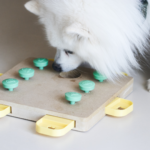Introduction
Bringing a playful puppy into your home is a heartwarming experience, but the teething stage can pose challenges for both pet and owner. In this guide, we’ll explore the ins and outs of puppy teething, emphasizing its significance and the goal of providing practical solutions for a harmonious teething experience.
Understanding Puppy Teething
Puppyhood is a delightful phase marked by boundless energy, curiosity, and, of course, teething. Teething is a natural process in which a puppy’s baby teeth fall out, making way for their adult set. While this developmental milestone is a sign of healthy growth, it can pose challenges for both the puppy and their owner. Teething typically begins around three weeks of age and continues until the puppy is around six months old. During this period, puppies experience discomfort and an instinctive urge to chew to alleviate the pain and facilitate the shedding of their baby teeth.
Challenges Faced by Puppy Owners
Embarking on the journey of raising a puppy brings immeasurable joy but also introduces its fair share of challenges, especially during the teething phase. Understanding and addressing these challenges is pivotal for both the well-being of the puppy and the sanity of the owner.
Teething is a natural process for puppies, but it can be a challenging time for owners as the puppy’s instinct to chew intensifies. This can lead to furniture and belongings becoming unintended casualties. Providing a variety of appropriate chew toys specifically designed for teething puppies can redirect their chewing instincts. Subtle mentions of teething gels or frozen washcloths as soothing aids can guide owners toward helpful resources without overt promotion.
One of the common issues during teething is the increased sensitivity and irritability of the puppy. This may manifest in behavioral changes like increased biting or whining. Gentle and positive reinforcement, along with patience, is essential during this period. Avoiding punishment and offering soft treats can provide comfort without exacerbating the sensitivity.
Ensuring Proper Dental Care
Ensuring proper dental care for teething puppies is a fundamental aspect of responsible pet ownership that contributes to their overall health and well-being. As adorable as teething puppies may be, they often face challenges that demand attention to their dental hygiene.
Teething puppies often face the challenge of discomfort and pain as their adult teeth emerge. This discomfort can lead to excessive chewing, which, if not addressed, may contribute to dental issues in the long run. Introducing appropriate chew toys during this phase is recommended.
One potential issue is the lack of awareness among puppy owners regarding the importance of dental care during the teething phase. Many may not realize that teething can lead to discomfort and irritation, making puppies more susceptible to oral health issues. Practical solutions include introducing appropriate dental care routines early in a puppy’s life. Gentle brushing with a soft toothbrush and puppy-friendly toothpaste can help prevent plaque buildup and maintain good oral health. However, a challenge arises when owners struggle with acclimating their puppies to toothbrushing. It is recommended that gradual introduction, positive reinforcement, and using flavored toothpaste can ease this challenge.
Soothing Solutions at Home
Teething puppies often experience discomfort and may exhibit unwanted behaviors such as chewing on furniture, excessive drooling, or even changes in appetite. Identifying these signs can be a challenge for puppy owners, especially those new to the responsibilities of caring for a growing dog. Therefore, one potential issue is the lack of awareness about effective home-based soothing solutions.
Chew toys made from durable, puppy-safe materials is recommended to alleviate discomfort and satisfy the puppy’s natural urge to chew. However, potential challenges arise if owners are unsure about choosing the right toys or if their puppy shows no interest in them. Selecting appropriate toys and trying various textures to find what suits the puppy can be beneficial. Additionally, homemade frozen treats or ice cubes can be suggested to numb sore gums. Ensure that these treats are not too hard or small, as it could be a potential choking hazard.
Seeking Professional Guidance
Ensuring the well-being of teething puppies often requires the expertise of professionals who specialize in veterinary care and puppy development. Seeking professional guidance during this crucial phase can significantly contribute to a puppy’s overall health and behavior.
One potential issue is the lack of awareness among puppy owners about when to seek professional help. Teething puppies may exhibit various behaviors, and distinguishing normal teething-related discomfort from more severe issues can be challenging. Common signs that might warrant professional attention include persistent pain, excessive bleeding, or difficulty eating, subtly guides owners on when to consult a veterinarian.
Encouraging puppy owners to establish a relationship with a trusted veterinarian early on is a practical solution. This helps create a support system for addressing teething challenges and ensures that professional advice is readily available when needed.
Conclusion
In conclusion, guiding your puppy through the teething stage is a rewarding journey that strengthens the bond between you and your furry friend. By understanding the natural process of teething, addressing common challenges with practical solutions, and prioritizing proper dental care, you’re ensuring not only a comfortable experience for your puppy but also setting the foundation for a lifetime of good oral health. Remember, patience, positive reinforcement, and a proactive approach to care are key to navigating this developmental milestone successfully. As you implement these strategies, relish in the joy of witnessing your puppy grow into a happy, healthy, and well-adjusted companion. Here’s to many more delightful moments and wagging tails ahead!









